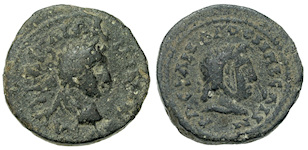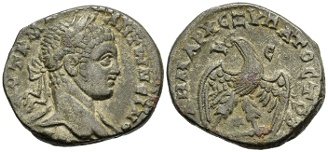Fine Coins Showcase
Antiquities Showcase
Show Empty Categories
Shop Search
Shopping Cart
My FORVM
Contact Us
About Forum
Shopping at Forum
Our Guarantee
Payment Options
Shipping Options & Fees
Privacy & Security
Forum Staff
Selling Your Coins
Identifying Your Coin
FAQs
zoom.asp
Home ▸ Catalog ▸ |Roman Coins| ▸ |The Severan Period| ▸ |Elagabalus||View Options:   | | | | | | Elagabalus came to power through the scheming of his grandmother Julia Maesa. Elagabalus repeatedly shocked the population with increasingly bizarre behavior including cross-dressing and marrying a vestal virgin. Eventually, his grandmother replaced him on the throne with Severus Alexander, and Elagabalus and his mother were murdered, dragged through the streets of Rome, and dumped into the Tiber. |


Jerash, Jordan is north of the national capital Amman. Inhabited since the Bronze Age, it's known for the ruins of the walled Greco-Roman city Gerasa just outside the modern city. Josephus mentions the city as being principally inhabited by Syrians, but also having a small Jewish community. In 106, Jerash was absorbed into the Roman province of Arabia, which included Philadelphia (modern day Amman). Jerash is considered one of the largest and most well-preserved sites of Roman architecture outside of Italy. It is sometimes referred to as the "Pompeii of the Middle East" due to its size, extent of excavation and level of preservation.RP57203. Bronze AE 20, RPC Online VI T9306.4 (same c/m, 7 spec.); Spijkerman 34a.3 (same coin); Rosenberger 41 (same c/m); Sofaer 32; c/m: Howgego 376 (9 spec.), Choice F, well centered, nice sea-green patina, rare fully legible rev. legend; c/m: F, weight 7.065 g, maximum diameter 19.7 mm, die axis 180o, Gerasa (Jerash, Jordon) mint, c. 218 - 222 A.D.; obverse AVT KAICAP ANTWNINOC, laureate and draped bust right, seen from behind; reverse AΛEΞANΔPOC MAKEΔWN, diademed head of Alexander the Great right, countermark: strung bow; very nice for the type!; very rare;
Elagabalus, 16 May 218 - 11 March 222 A.D., Neapolis, Samaria, Syria Palestina


Neapolis, Samaria, the biblical Shechemis, is now Nablus, Israel. It is the site of Joseph's Tomb and Jacob's well. Jesus spoke here to a Samaritan woman. Neapolis is home to about half the remaining worldwide Samaritan population of 600.RP98112. Bronze AE 24, SNG ANS 1007 (same dies); cf. Rosenberger II 53; BMC Palestine p. 61, 103; Sofaer 109 - 110; Baramki AUB 36, nice VF, excellent portrait, attractive green patina with highlighting earthen deposits, some legend not fully struck, edge splits, weight 6.701 g, maximum diameter 24.1 mm, die axis 180o, Neapolis (Nablus, Israel) mint, 16 May 218 - 11 Mar 222 A.D.; obverse AVT K M AVP - ANTWNIN, laureate head right, slight drapery on left shoulder; reverse ΦΛ NE - CVP Π (Flavia Neapolis Syria Palestina), Tyche standing slightly left, head left, kalathos on head, rudder held by tiller in right hand, cornucopia in left hand; ex Menashe Landman Collection; rare;
Elagabalus, 16 May 218 - 11 March 222 A.D., Laodicea ad Mare(?), Seleukis and Pieria, Syria


McAlee interprets Δ - E as "Δ EΠAPCEIΩN," meaning "of the four eparchies" and notes, "After Septimius stripped Antioch of its privileges and conferred them on Laodicea-ad-Mare, some coins of Laodicea bear the legend 'Metropolis of the Four Provinces,' and others have a representation of four Tyches. The letters ΔE also regularly appear on the coins of Laodicea from the time of Elagabalus to that of Trebonianus Gallus." McAlee also notes that Severan era coins of Laodicea have a star between the eagles legs, perhaps referring to the beacon of Laodicea's lighthouse.RY113505. Billon tetradrachm, McAlee 758, SNG Cop 237, Prieur 249, Bellinger Syria 42, Dura Coins -, gVF, tight flan, rev. slightly off center, weight 12.876 g, maximum diameter 26.2 mm, die axis 0o, Laodicea ad Mare (Latakia, Syria) mint, 219 A.D.; obverse AVT K M A ANTWNEINO-C CEB, laureate bust right, drapery on left shoulder, both wreath ties behind neck; reverse ΔHMAPX EΞOYCIAC YΠ B (holder of Tribunitian power, consul for the second time), eagle standing facing, wings spread, head left, wreath in beak, Δ - E (Δ EΠAPCEIΩN - of the four eparchies) flanking eagle's head, star between legs;
Elagabalus, 16 May 218 - 11 March 222 A.D., Laodicea ad Mare(?), Seleukis and Pieria, Syria


This type is traditionally assigned to Antioch but McAlee identifies Laodicea as the most likely mint. McAlee notes, "After Septimius stripped Antioch of its privileges and conferred them on Laodicea-ad-Mare, some coins of Laodicea bear the legend 'Metropolis of the Four Provinces,' and others have a representation of four Tyches. The letters Δ - E also regularly appear on the coins of Laodicea from the time of Elagabalus to that of Trebonianus Gallus."RY113495. Billon tetradrachm, McAlee 758, SNG Cop 237, Prieur 249, Bellinger Syria 42, Dura Coins -, VF, toned, tight thick flan, weight 13.213 g, maximum diameter 24.4 mm, die axis 0o, Laodicea ad Mare (Latakia, Syria) mint, 219 A.D.; obverse AVT K M A ANTWNEINOC CEB, laureate bust right, drapery on left shoulder, both wreath ties behind neck; reverse ΔHMAPX EΞOYCIAC YΠ B (holder of Tribunitian power, consul for the second time), eagle standing facing, wings spread, head left, wreath in beak, Δ - E (Δ EΠAPCEIΩN - of the four eparchies) flanking eagle's head, star between legs;
Elagabalus, 16 May 218 - 11 March 222 A.D., Laodicea ad Mare, Seleukis and Pieria, Syria


McAlee interprets Δ - E as "Δ EΠAPCEIΩN," meaning "of the four eparchies" and notes, "After Septimius stripped Antioch of its privileges and conferred them on Laodicea-ad-Mare, some coins of Laodicea bear the legend 'Metropolis of the Four Provinces,' and others have a representation of four Tyches. The letters ΔE also regularly appear on the coins of Laodicea from the time of Elagabalus to that of Trebonianus Gallus." McAlee also notes that Severan era coins of Laodicea have a star between the eagles legs, perhaps referring to the beacon of Laodicea's lighthouse.RY113496. Billon tetradrachm, cf. McAlee 766 (ex. rare), Prieur -, SNG Cop -, SNG Righetti -, SNG MŁnchen -, SNG Hunterian -, BMC Syria -, aVF, toned, tight flan, scratches, deposits, weight 10.825 g, maximum diameter 24.8 mm, die axis 180o, Laodicea ad Mare (Latakia, Syria) mint, 219 A.D.; obverse AVT K M A ANTWNEINOC CEB, laureate and draped bust right, seen from behind, no pteruges on shoulder; reverse ΔHMAPX EΞ YΠATOC TO B (holder of Tribunitian power, consul for the 2nd time), eagle standing facing, wings spread, head and tail right, wreath in beak, Δ - E flanking above wings, star between legs; extremely rare;
Elagabalus, 16 May 218 - 11 March 222 A.D., Laodicea ad Mare(?), Seleukis and Pieria, Syria


McAlee interprets Δ - E as "Δ EΠAPCEIΩN," meaning "of the four eparchies" and notes, "After Septimius stripped Antioch of its privileges and conferred them on Laodicea-ad-Mare, some coins of Laodicea bear the legend 'Metropolis of the Four Provinces,' and others have a representation of four Tyches. The letters ΔE also regularly appear on the coins of Laodicea from the time of Elagabalus to that of Trebonianus Gallus." McAlee also notes that Severan era coins of Laodicea have a star between the eagles legs, perhaps referring to the beacon of Laodicea's lighthouse.RY113504. Billon tetradrachm, McAlee 758, SNG Cop 237, Prieur 249, Bellinger Syria 42, Dura Coins -, VF, toned, centered on a tight flan, weight 11.404 g, maximum diameter 26.8 mm, die axis 0o, Laodicea ad Mare (Latakia, Syria) mint, 219 A.D.; obverse AVT K M A ANTWNEINO-C CEB, laureate bust right, drapery on left shoulder, both wreath ties behind neck; reverse ΔHMAPX EΞOYCIAC YΠ B (holder of Tribunitian power, consul for the second time), eagle standing facing, wings spread, head left, wreath in beak, Δ - E (Δ EΠAPCEIΩN - of the four eparchies) flanking eagle's head, star between legs;


Providentia is the personification of the ability to foresee and to make provision for the future. This ability was considered essential for the emperor and providentia was among the embodiments of virtues that were part of the imperial cult. Cicero said that providentia, memoria (memory) and intellegentia (understanding) are the three main components of prudentia, the knowledge what is good or bad or neither.RS112932. Silver denarius, Hunter III p. 116, 37 (also obv. leg. unbroken); RIC IV 130; RSC III 244; BMCRE V 158; SRCV II 7541, Choice VF, well centered, flow lines, die wear, tiny edge cracks, weight 2.876 g, maximum diameter 19.8 mm, die axis 180o, Rome mint, c. 219 A.D.; obverse IMP ANTONINVS AVG, laureate and draped bust right, seen from behind; reverse PROVID DEORVM (to the foresight of the gods), Providentia standing slightly left, head left, legs crossed, leaning with left elbow on column, rod in right hand held over over globe at feet on right, cornucopia in left hand; $100.00 (Ä94.00) ON RESERVE
Elagabalus, 16 May 218 - 11 March 222 A.D., Laodicea ad Mare(?), Seleukis and Pieria, Syria


This type is traditionally assigned to Antioch but McAlee identifies Laodicea as the most likely mint. McAlee notes, "After Septimius stripped Antioch of its privileges and conferred them on Laodicea-ad-Mare, some coins of Laodicea bear the legend 'Metropolis of the Four Provinces,' and others have a representation of four Tyches. The letters Δ - E also regularly appear on the coins of Laodicea from the time of Elagabalus to that of Trebonianus Gallus."RP114572. Billon tetradrachm, McAlee 758, SNG Cop 237, Prieur 249, Bellinger Syria 42, Dura Coins -, F, toned, off center, weight 12.559 g, maximum diameter 25.7 mm, die axis 180o, Laodicea ad Mare (Latakia, Syria) mint, 219 A.D.; obverse AVT K M A ANTWNEINOC CEB, laureate bust right, drapery on left shoulder, both wreath ties behind neck; reverse ΔHMAPX EΞOYCIAC YΠ B (holder of Tribunitian power, consul for the second time), eagle standing facing, wings spread, head left, wreath in beak, Δ - E (Δ EΠAPCEIΩN - of the four eparchies) flanking eagle's head, star between legs;
Elagabalus, 16 May 218 - 11 March 222 A.D., Antioch, Seleucis and Pieria, Syria


McAlee notes that ΔE probably abbreviates Δ EΠAPCEIΩN, meaning "of the four eparchies.RY114963. Bronze as, BMC Galatia p. 203, 440; McAlee group 1, 777(c); Lindgren I 2004; SNG Righetti 2001; Waage 583; RPC Online VI T8037, Choice VF, near centered, nice portrait, dark patina, attractive contrasting earthen deposits (Syrian patina), weight 4.411 g, maximum diameter 18.9 mm, die axis 135o, Antioch (Antakya, Turkey) mint, 16 May 218 - 11 Mar 222 A.D.; obverse AVT K M AVP ANTΩNINOC C, laureate head right; reverse S C, Δ above, E (lunate) below, all within laurel wreath, fastened at the top with a star;
Elagabalus, 16 May 218 - 11 March 222 A.D., Laodicea ad Mare(?), Seleukis and Pieria, Syria


This type is traditionally assigned to Antioch but McAlee identifies Laodicea as the most likely mint. McAlee notes, "After Septimius stripped Antioch of its privileges and conferred them on Laodicea-ad-Mare, some coins of Laodicea bear the legend 'Metropolis of the Four Provinces,' and others have a representation of four Tyches. The letters Δ - E also regularly appear on the coins of Laodicea from the time of Elagabalus to that of Trebonianus Gallus."RY111669. Billon tetradrachm, McAlee 758, Bellinger Syria 42, SNG Cop 236, Prieur 267 var. (linear wings), Dura Coins -, aVF, oval flan, porous/rough, weight 11.137 g, maximum diameter 25.8 mm, die axis 0o, Laodicea ad Mare (Latakia, Syria) mint, 219 A.D.; obverse AVT K M A ANTWNEINOC CEB, laureate bust right, drapery on left shoulder, both wreath ties behind neck; reverse ΔHMAPX EΞOYCIAC YΠ B (holder of Tribunitian power, consul for the second time), eagle standing facing, wings spread, head left, wreath in beak, Δ - E (Δ EΠAPCEIΩN - of the four eparchies) flanking eagle's head, star between legs;
CLICK HERE TO SEE MORE FROM THIS CATEGORY - FORVM's PRIOR SALES



OBVERSE| LEGENDS|
REFERENCES|
Page created in 1.266 seconds.








